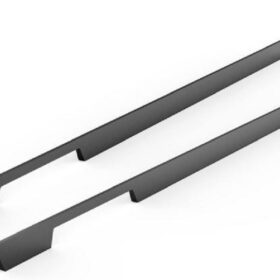The Science Behind Ergonomic Modern Cabinet Door Handles
In the realm of home design, functionality and aesthetics reign supreme. Nowhere is this more evident than in the humble cabinet door handle. This seemingly innocuous component plays a pivotal role in the user experience, bridging the gap between form and function.
Modern cabinet door handles are not merely decorative accoutrements; they are meticulously engineered to enhance comfort, reduce strain, and promote healthy movement. Ergonomics, the science of designing products that fit the human body, has revolutionized the design of these handles, creating solutions that are both pleasing to the eye and a boon for our well-being.
The Gripping Zone: A Symphony of Comfort
The gripping zone, the primary contact point between the user and the handle, is meticulously designed to minimize hand fatigue and optimize grip. Textured surfaces provide a secure hold, while rounded edges prevent discomfort and pressure points. Handles with a wider diameter and deeper grooves accommodate a wider range of hand sizes, ensuring a comfortable grip for all users.
Leverage and Biomechanics: Empowering Effortless Opening
Leverage, the principle of using a lever to magnify force, plays a crucial role in ergonomic handle design. Handles with longer levers reduce the force required to open cabinet doors, making it easier for users with limited strength or dexterity. Additionally, biomechanical considerations ensure that the handle’s position and orientation align with the natural movement of the hand, minimizing strain on the wrist and forearm.
Materials Matter: Durability and Hygiene
The choice of materials for ergonomic cabinet door handles extends beyond aesthetics. Durable materials such as stainless steel, aluminum, and zinc alloys resist wear and tear, ensuring years of reliable use. Antibacterial coatings minimize the accumulation of germs, promoting hygiene in the kitchen and bathroom.
Adapting to Diverse Needs
The diversity of users necessitates a wide range of ergonomic handle options. Handles can be designed to accommodate left-handed users, provide support for individuals with limited mobility, or incorporate features such as touchless opening for enhanced accessibility.
The science behind ergonomic modern cabinet door handles is a testament to the power of design to improve our everyday lives. By incorporating principles of ergonomics, handle designers create solutions that enhance user comfort, reduce strain, and promote healthy movement. These seemingly small details make a profound difference, transforming everyday interactions with our homes into seamless and enjoyable experiences.
-
2024-11-29Top Trends in Modern Kitchen Cabinet Pulls for 2024
-
2024-11-28The Ultimate Guide to Modern Kitchen Cabinet Pulls- Materials, Styles, and Tips
-
2024-11-27Elevate Your Kitchen Design with These Must-Have Modern Cabinet Pulls
-
2024-11-26Sleek and Stylish- The Best Modern Kitchen Cabinet Pulls for a Contemporary Look










